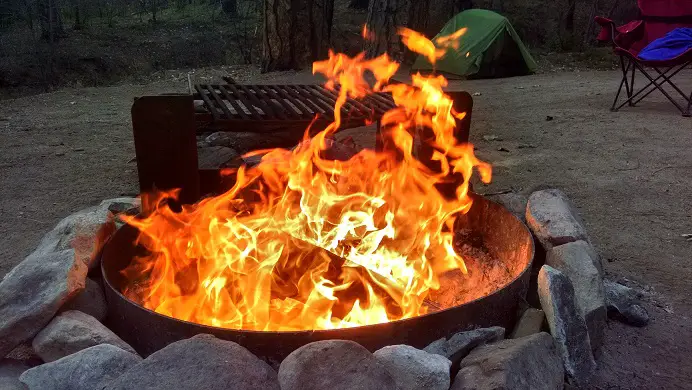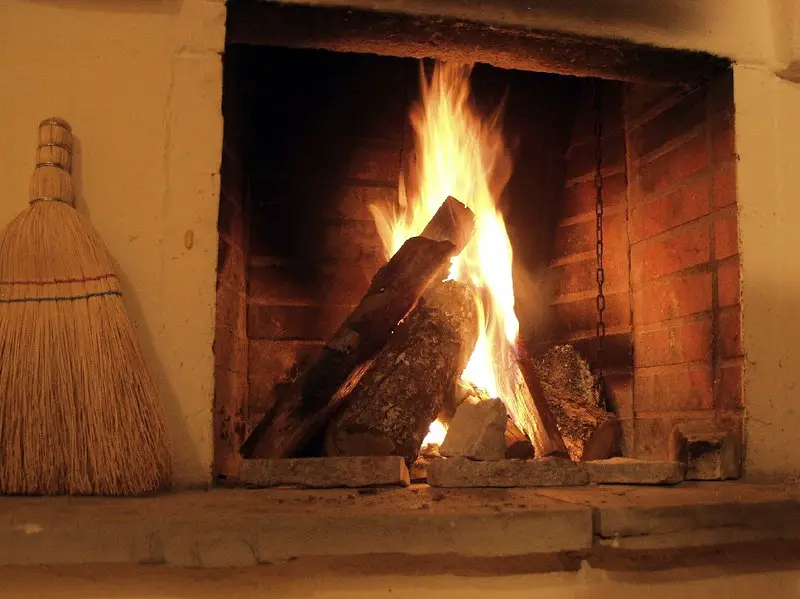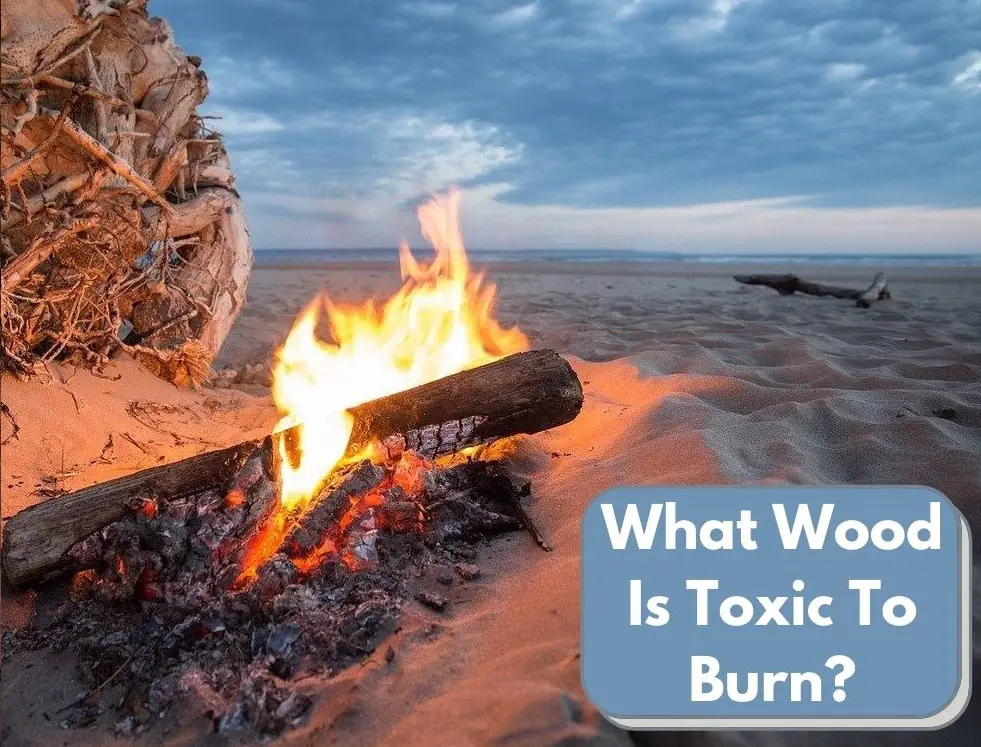Whether you’re camping, at home by the fireplace, or out at the fire pit, the smell and allure of a wood-burning fire is hard to beat. But look before you throw just any log on the pile, as you must know what wood is toxic to burn to keep you and your family safe.
You should not burn poisonous trees like poison oak, driftwood, fresh or green wood, moldy or rotten wood, wood that is not local to the area, manmade wood products, or wood from furniture as they all pose potential health risks and are toxic in different ways.
We’ll further cover what types of wood you should not burn in today’s guide to make sure your time by the fire is enjoyable and safe for everyone involved.

What Wood Is Toxic To Burn In A Fire?
There are quite a few different types of wood that you should not burn in your fireplace, campfire, or fire pit.
Burning bad types of wood can pose harmful risks to you and the environment as well, so we’ll cover what woods not to burn:
Mexican Elder
Mexican elder is a type of softwood found in the Southern U.S. and in California that releases cyanide into the air when the wood and leaves are burned.
It doesn’t matter whether the wood is green or dried – it still contains cyanide!
Poison Oak
Burning poison oak can release it’s toxins into the air and can affect you or other people downwind through settling on their skin or clothes or by breathing in the vapors.
Don’t Burn These Poisonous Plants Either:
- Poison Ivy
- Poison Sumac
- Water Hemlock
- Mexican Pepper
- Oleander (Burning Oleander releases the toxin oleandrin into the air which can affect your heart, lungs, nervous system, and more in some seriously negative ways)
Manchineel
The Manchineel tree is mostly in Florida within the U.S., but can also be found in Mexico, Central America, northern South America, the Carribean, and The Bahamas.
All parts of the Manchineel tree contain toxins and can cause blistering of the skin – the sap can even damage the paint on cars.
You do not want to be breathing in any type of smoke or handling wood from a Manchineel tree.
Green Wood Or Fresh Wood
Don’t just grab any wood you find, as non-dried wood (also referred to as green wood or fresh wood) hasn’t had time to let the water or sap in the wood release and dry out.
When you burn green wood, the water and sap can boil, creating a lot of smoke, and can lead to smoke inhalation.
Fresh wood can also build up creosote in your chimney which can create a fire risk.
Wood should ideally be aged 6-12 months after being cut to be considered “seasoned” or fire-ready.
Driftwood
Driftwood is never safe to burn whether it’s from freshwater or saltwater – even if it’s dry.
Driftwood from the ocean absorbs lots of salt, which is released in the form of chloride (or chlorine) when burned, creating cancerous fumes.
Freshwater driftwood is not any safer, as it tends to have a lot of fungus and mold growing on or in it, and burning it will release the spores into the air which can then be inhaled.
Rotten Or Moldy Wood
Don’t burn moldy or rotten wood as you risk inhaling the spores or getting them on your food as it burns.
Always inspect your wood to make sure it’s dry and free of insects or mold before starting your fire.
Furniture Wood
Although most types of wood used for building of furniture are non-toxic, the glues, stains, and pesticides furniture wood is treated with can be harmful if inhaled.
Softwoods
Soft woods burn very fast, which can be tempting to use when starting a fire, but they also create a lot of smoke – smoke inhalation is not good for anyone, so we recommend avoiding softwoods.
Some common softwoods include Southern Yellow Pine, Douglas Fir, Lodgepole Pine, Scots Pine, Western Red Cedar, Eastern White Pine, Parana Pine, European Spruce, and Western Hemlock.
Non-Local Wood
As a rule, never bring wood from home when you go camping, as you risk introducing non-native pests to the area which can spread and wreak havoc on the local environment.
Pressure-Treated Wood
Pressure treated wood is sprayed with chemicals to help the wood last longer.
When burned, those chemicals are released into the air which can cause irritation, shortness of breath, and damage to your lungs.
Wood Pallets
Wood pallets are often treated with pesticides and preserving chemicals in the same manner that pressure-treated wood is, so wood pallets are not good for burning.
Plywood, Particle Board, & Chipboard
Plywood and other manmade or inexpensive wood products are not suitable for burning because of the added plastics, paints, glues, and other foreign substances which can become toxic gases when burned.
These toxic gases are not good for you or the environment, so don’t burn manmade wood products indoors or outdoors.
Stained Wood
Think about this for a minute: if the can of stain itself has warnings about toxic fumes and working in a well-ventilated space, then the same rules apply to breathing in the stain as it burns. Not good.

What Other Types Of Wood Should You Not Burn?
Other types of wood may not be harmful, but they’re not safe or logical to burn either, which we’ll also cover here.
Large Pieces Of Wood
If your firewood can’t fit inside your firepit, fireplace, or campfire, it’s not safe to use.
This wood can shift weight as it burns down which can cause embers to fly or even a piece of burning wood to fall out of the fire area, creating a hazard.
As a general rule of thumb, you should split or recut pieces of wood that are more than 5” in diameter.
Christmas Trees, Evergreen Trees, and Coniferous Trees
Christmas trees and evergreen trees aren’t toxic, but they produce a lot of smoke because of all the sap in them, which can increase your risk of smoke inhalation.
The woods from Coniferous trees (that is, trees that have needles instead of leaves) create a lot of sparks which is a hazard in general, and the pitch (or wood tar) in coniferous trees can lead to creosote buildup in chimneys.
Pine needles can also float above the fire, creating an airborne fire risk or creosote sparking hazard.
Hemlock
(FYI – we’re not talking about the hemlock plant here, we’re discussing the hemlock tree):
Although hemlock is a coniferous tree, the wood is absurdly hard to split, burns terribly, and makes tons of sparks. Do not bother with hemlock!
Certain Deciduous Trees
Specific deciduous trees like Willow, Aspen, and Basswood don’t burn well and give off very little heat, so while they’re relatively safe to burn in a survival situation, they’re not good for much else.
Wood Pulp Products
Products like cardboard, newspaper, wrapping paper, and magazines can result in long-lasting embers that can float away from your campfire sparking a forest fire, or up your chimney to start a creosote fire.
Endangered Species Of Trees Not To Burn
Sometimes it’s not a matter of wood not being safe to burn, but it being illegal to do so.
Although it’s almost impossible that you’ll find endangered species of trees for sale at your local firewood outlet, be aware of them so you don’t accidentally get yourself in trouble by cutting one down when camping.
Some well-known endangered tree species include the American Chestnut, Florida Yew, Maple Leaf Oak, Fraser Fir, Blue Ash, and Kentucky Coffee tree.
FAQs About Types Of Wood Not To Burn
You should not burn wood that is not local to the area, manmade wood products, furniture, poisonous trees like poison oak, driftwood, fresh or green wood, or moldy/rotten wood as they all pose potential health risks and are toxic in different ways.
Wood smoke from seasoned non-toxic woods is not toxic, but still poses health risks from smoke inhalation and air pollutants released by burning wood.
Always attempt to limit breathing in smoke from a campfire, chimney, or fire pit, and position yourself far enough away so you can get fresh air.

